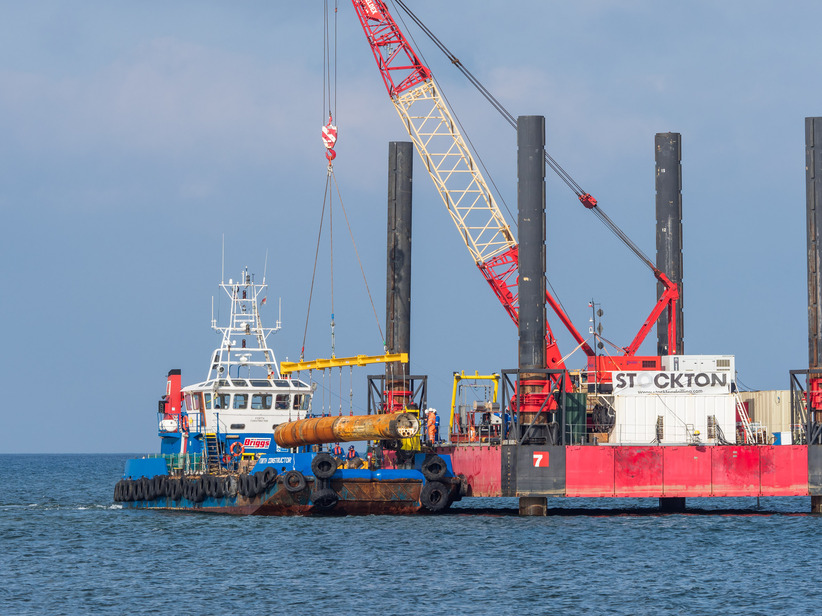Offshore Spreader Beams: Top 6 Tips for Offshore Lifts

- The Demands of Offshore Lifting
- Material Selection and Surface Protection
- Design Considerations for Harsh Environments
- Testing and Compliance
- Logistics, Handling and Lifecycle Maintenance
- Sustainability in Offshore Lifting Equipment
- Conclusion
Offshore lifting operations present some of the most demanding challenges in the lifting industry. From severe weather and salt-laden air to strict safety regulations and remote locations, the conditions offshore are uniquely harsh. Lifting beams—especially spreader beams—play a critical role in ensuring safe and stable lifts in these environments. This article explores how lifting beams are designed, selected, and maintained for offshore use, and what considerations engineers and operators must make when working in marine settings.
The Demands of Offshore Lifting
Offshore environments subject lifting equipment to conditions that far exceed those onshore. Corrosive saltwater exposure, unpredictable weather, and limited accessibility all influence how lifting operations are planned and executed. These conditions require lifting beams that are robust, modular, and compliant with offshore lifting standards such as DNV-ST-N001 and EN 13852-1.
Key challenges include:
- Corrosion Resistance: Constant exposure to sea spray and humid air accelerates corrosion in steel components.
- Fatigue and Wear: Dynamic loads from waves and vessel movement can cause additional stress on lifting equipment.
- Transport and Handling: Lifting beams must often be transported to offshore locations, which adds to the logistical complexity.
- Hydrostatic Pressure: Subsea lifting beams are specifically engineered to withstand significant hydrostatic pressures encountered at depth. As water depth increases, so does the pressure exerted on equipment. For instance, at 100 meters depth, the pressure is approximately 10 bar (145 psi). These beams must maintain structural integrity under such conditions, ensuring safety and reliability during subsea operations.
Material Selection and Surface Protection
High-grade structural steel is the material of choice for most offshore spreader beams due to its strength and durability. However, material selection is just one aspect—coating systems are equally vital.
To withstand corrosion:
- Galvanizing or marine-grade paint systems are used to protect the steel surface.
- Surface preparation (e.g. SA2.5 blast cleaning) ensures coating adhesion.
- Touch-up and inspection regimes are typically part of regular maintenance schedules.
For offshore spreader beams, certification of coatings according to standards like ISO 12944 or NORSOK M-501 is often required.
Design Considerations for Harsh Environments
Modular spreader beams are commonly used offshore due to the following factors:
- Modular design: Enables efficient transport and flexibility in configuration.
- Lightweight construction: Reduces the load on cranes, especially on floating assets.
- Load distribution: Spreader beams effectively distribute the load, reducing stress on lifting points.
In offshore settings, beams must be designed to accommodate dynamic factors like sling angle variations, load sway, and impact loading. Certification by a third-party authority, such as DNV, is frequently mandated for offshore projects. All Modulift spreader beams are DNV Type approved up to 2000t.
Logistics, Handling, and Lifecycle Maintenance
Due to space constraints offshore, lifting equipment must be easy to assemble, disassemble, and store. Beams are delivered in modular sections that can be bolted together on-site.
Maintenance protocols offshore are stricter due to the high cost of downtime and the difficulty of replacement. Regular inspection routines focus on:
- Coating integrity
- Connector and bolt inspection
- Markings and traceability
- Welding seam conditions
Designing beams with long service life and low maintenance requirements helps reduce both operational cost and environmental impact.
Sustainability in Offshore Lifting Equipment
Although durability is the primary concern in harsh environments, sustainability is becoming increasingly important in offshore sectors. Lifting beams with modular, reusable designs help reduce waste and extend the equipment lifecycle.
At Modulift, for example, modular spreader beams are designed to be reconfigurable, reducing the need for custom solutions on every project. The use of recyclable materials such as structural steel, along with local sourcing practices, helps minimise the environmental footprint of offshore lifting operations.
Conclusion
Lifting in offshore environments is complex, high-risk, and demands specialist equipment. From material selection and corrosion protection to compliance testing and sustainable design, every aspect of a spreader beam’s construction and use must be tailored for harsh offshore conditions. By understanding these considerations, lifting engineers and project planners can ensure safer, more reliable operations—no matter how demanding the environment.
To discuss how Modulift can help with your next offshore lift, contact the sales team today on +44(0)1202 621 511 or email [email protected]